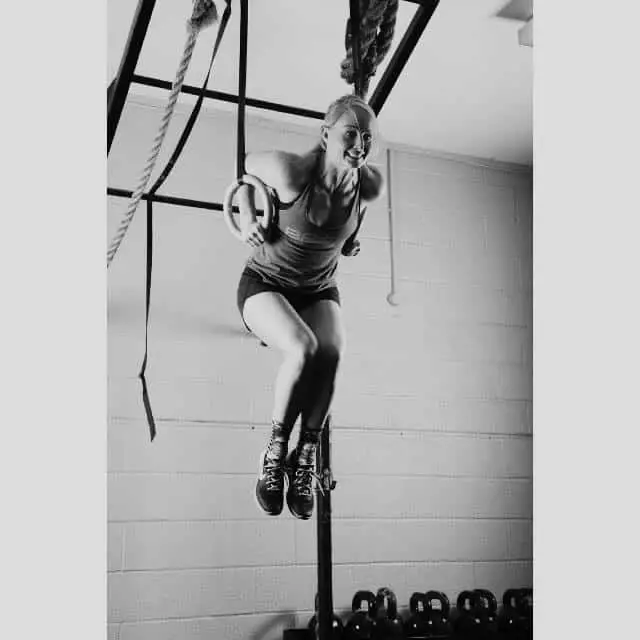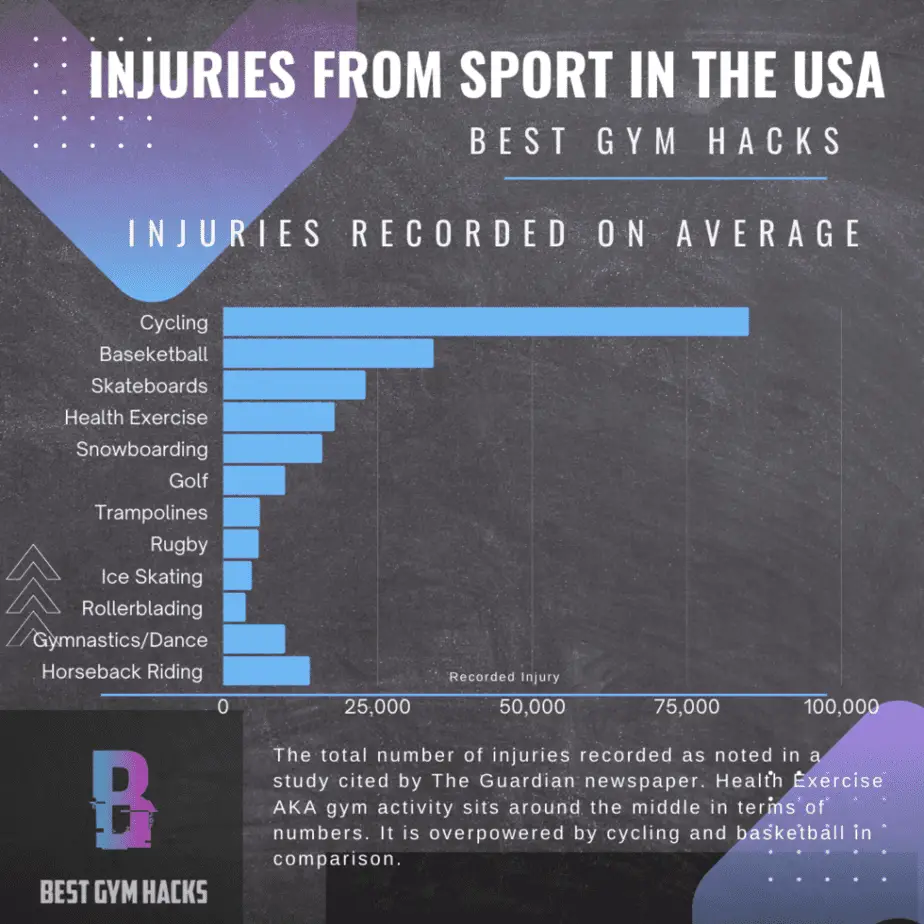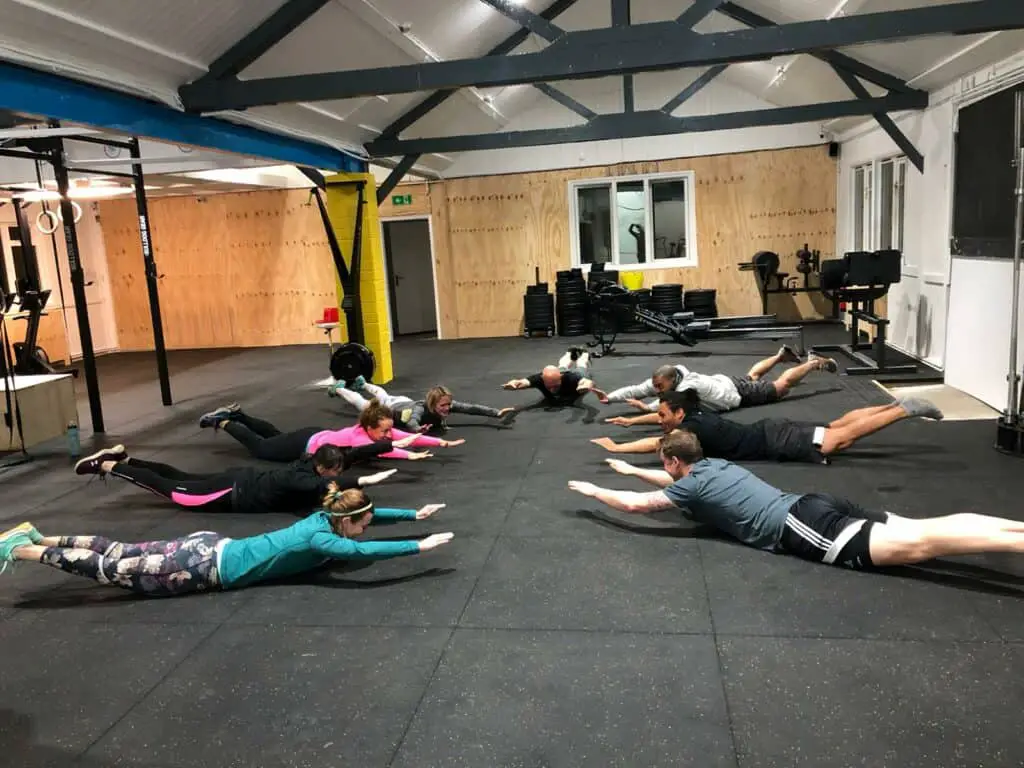CrossFit is bad for you if carried out improperly, ignoring health and safety guidance, or not within the protocols in its training manual. Studies have shown that injuries are actually more common in non-CrossFit affiliated gyms. On the contrary, when executed properly, CrossFit is in fact very good for you. The benefits can be seen physically as well as mentally, with a high percentage of members claiming how it’s transformed their lives since joining a CrossFit gym.

Can You Get Injured Doing CrossFit?
As with any sport, there is a risk of sustaining injury. You might have read that CrossFit is bad as you always get injured; or that it’s bad on your joints. But is this really the case?
An article in The Guardian reviews the danger of sports, in particular skiing and snowboarding. According to The Metro Newspaper’s survey, sprained ankles, bad backs and broken limbs are the top 3 ‘gymjuries’.
The article also cites the number of casualty (emergency room) admissions for head injuries in the USA, for various sports.
A numbers game
The total number of people should be considered when reviewing the numbers of course (the more popular the sport, the higher rate of injury based on volume), but what this demonstrates is that most, if not all, sports will carry some element of risk.
If you’re wondering about what makes a CrossFit gym different to a ‘normal’ gym, this Best Gym Hacks article will explain.
The most common injuries are sprained ankles (21%), bad backs (18%), broken limbs (16%), chest pain (10%) and slipped discs (5%).
The Metro survey on mainstream gyms
CrossFit is known as The Sport of Fitness. But for many, it’s just going to the gym. So how is it bad for you and how do can you get injured?

How Do You Get Injured In CrossFit?
Bad form, poor technique and lifting above your capability are the most common causes of injury. Accidents by collision or clumsiness are also a factor.
Movements such as Box Jumps or the Snatch can induce a higher injury rate, but the risk can be mitigated significantly by listening to coaching and well thought out programming, as we’ll see later on.
The highest number of accidents I’ve seen in over 12 years of doing it is Box Jumps. It wins by a country mile.
Too big for your boots
We’ve all seen that person trying to Deadlift far more than they should be. It’s known as ‘prawn-back’ in the UK for the very simple reason that the person’s form is akin to a hunched over prawn (or shrimp for our North American cuzzies). Not a pretty sight.

However, take a stroll into any standard gym and behold…. he multitude of unguided poor form that plagues the floor. Unguided and non-supervised poor form runs deep.
Unsupervised vs Supervised
In non-CrossFit gyms, without a Personal Trainer (PT), people are working under their own instruction without correction.
There are mirrors, but often not used to review form. Observations lead one to think they’re used more so to check vein pump…
“5% of gym-goers say they were never taught how to use machinery properly when they first joined. We’re also running too far without pacing ourselves, AND we’re lifting weights that are way too heavy.”
THE METRO – UK NEWSPAPER
So there is a strong case that working out in a gym on your own carries a greater degree of risk for injury.
A study by solicitors Harward Barker showed that up to 45% of British gym-goers had injured themselves whilst trying to get fit.
That’s a lot of injuries.
Gymjury
They coined this “gym-jury”, and have put it down to lack of know-how, or badly executed movements.
According to The Metro,
“12% have had to seek medical advice for a sports or exercise related injury, with 5% having to consistently visit physiotherapists or chiropractors for long-term injuries”.
Metro Report
Given CrossFit is less mainstream than ‘globo-gyms’, it kind of debunks the myth that by doing CrossFit you’re more susceptible to injury.
The article goes on to say:
“5% of gym-goers say they were never taught how to use machinery properly when they first joined. We’re also running too far without pacing ourselves, AND we’re lifting weights that are way too heavy.“

Considerate coaching
Any CrossFit gym worth their salt has competent and careful coaching. It cannot be ignored that the Level 1 is fairly easy to obtain, but it is also easy to fail. Each class is typically 12-14 people, with at least 1 and sometimes even 2 coaches.
Their duty is to coach the movements, correct form, manage health and safety and encourage members. Some view it as semi-PTing, as that’s how it manifests during classes.
Supervision is safety
With a coach in every class, this significantly reduces the risk of Joe Bloggs lifting more than they should, or poor form and over exertion; compared to Joe Blogs on his own in a globo gym.
The coaches are trained to ensure each member is working out within their appropriate parameters.
However, it is impossible to police the room entirely. So of course, you do have people ignoring advice and getting themselves injured in classes. That doesn’t mean it causes more injuries than a normal gym, however.
Is The Quality of Coaching in CrossFit Any Good?
Anyone coaching in a CrossFit gym has a qualification allowing them to do so. The CrossFit Level 1 is the basic course that enables someone to competently work as a coach in an affiliate.
The quality is dependent on various factors such as their prior knowledge, experience in the industry, interpersonal skills and general aptitude.
Whilst it’s been noted on forums and such that the quality of CrossFit coaching is poor, this is a somewhat broad and unfounded generalisation.
We do need to be aware of sub-par coaching and poor programming, as both certainly exist.
Mixed together you’ve got a recipe for no no.
Visited enough CrossFit gyms
I’ve been to over 70+ CrossFit gyms all over the world, and the coaching style can vary from place to place – but not by a whole lot.
I’ve noticed a common theme at every single one: we were supervised for the full hour, from warm up, through the strength and workout, right through to warm down.
You do not get this in a standard gym. So I always feel safe in a CrossFit gym. There is guidance, structure and supervision.
You will also invariably see a coach paying more attention to those who need it more, too.
They read the room – as they’re trained to do.
I’ve been to over 70+ CrossFit gyms all over the world, and the coaching style can vary from place to place – but not by a whole lot.
Best Gym Hacks
Bad programming
This can certainly be a source for injury too.
For instance, it would be unwise to put heavy Deadlifts, high rep DB Snatch, Barbell Squat Snatch and KB Swings all in the same workout.
Why?
Because it’s far too too ‘hingy’ at the mid-line, fatiguing the lower back. So the risk of lower back injury is heightened.
This is where careful and thoughtful programming comes into it. Coaches and CrossFit gym owners have a duty to ensure the members work out safely, not over applying strain on individual parts of the anatomy, as many of the workouts can be intense, inducing quicker fatigue as a matter of course.
Leave Your Ego At The Door. How Do I Scale CrossFit?
What’s useful, and a key element of CrossFit, is the scaling option.
This means taking a prescribed weight (RX) for the workout and reducing it down to a manageable level – suitable to your skill and strength.
Repetition count can also be scaled, or even substituted out altogether. Anyone can scale, and it is strongly advised for reasons such as carrying an injury, pregnancy, mobility, ability level, or any other reason that might make it unsafe to carry out the workout RX.
If you walk in and decide you want to avoid a certain exercise for whatever reason, this is encouraged in all CrossFit affiliates.
This method, along with coaching guidance and supervision, makes the environment safer for yourself and others.
Some people like to ignore advice (that’s fine, you signed the waiver) and lay their ego all over the floor instead.
Whilst this might cause an injury, normally it’s the seasoned guy or gal, and they do not achieve the correct stimulus designed for that workout intent.
For example:

Reps: 21/15/9 of:
Front Squat (FS) 80kg (male RX prescribed weight)
Toes To Bar (TTB)
Intent of this workout is fast and unbroken. To Front Squat 21 reps for 80kg unbroken would require you to be in approximately the top 10-12 percentile. Then top 20ish percentile for 21 unbroken Toes 2 Bar.
An imaginary story (which really happens)
Dave walks in. A big guy, but his legs are not very strong. His 1RM Front Squat is 110kg, so thinks this WOD is a bit of him. He can do 3 Toes 2 Bar at best, not linked very well (yet).
What should he do?
The clue was above. Dave should scale. Probably to say 60kg for the Squats. For TTB, he should do high knees instead, as he can link probably 11 and 10, then 10 and 5, then 9.
But Dave didn’t leave his ego at the door. Dave didn’t scale.
The WOD should have taken him 4-6 minutes. Instead, he broke the 80kg FS into shouty sets of 5’s. And did 75% of the TTB in unlinked singles. It took Dave 12.5 minutes.
So Dave missed the stimulus intent carefully crafted within the programming, and was still working out whilst everyone else was stretching off. Not to mention he was squatting more than he really should have been…
What’s The Point?
The point of this is that there’s method behind the CrossFit methodology. If you miss the point, you miss the point.
But your money your life right? Well yes, but it can uplift your chance of injury.
But this does not make CrossFit bad.
Make sure to check out this Best Gym Hacks article about how long it would take to see results.
